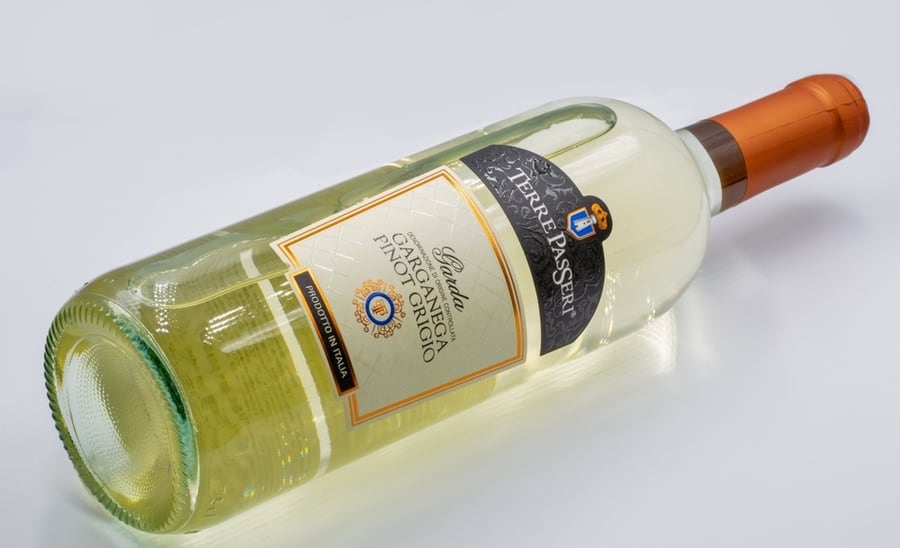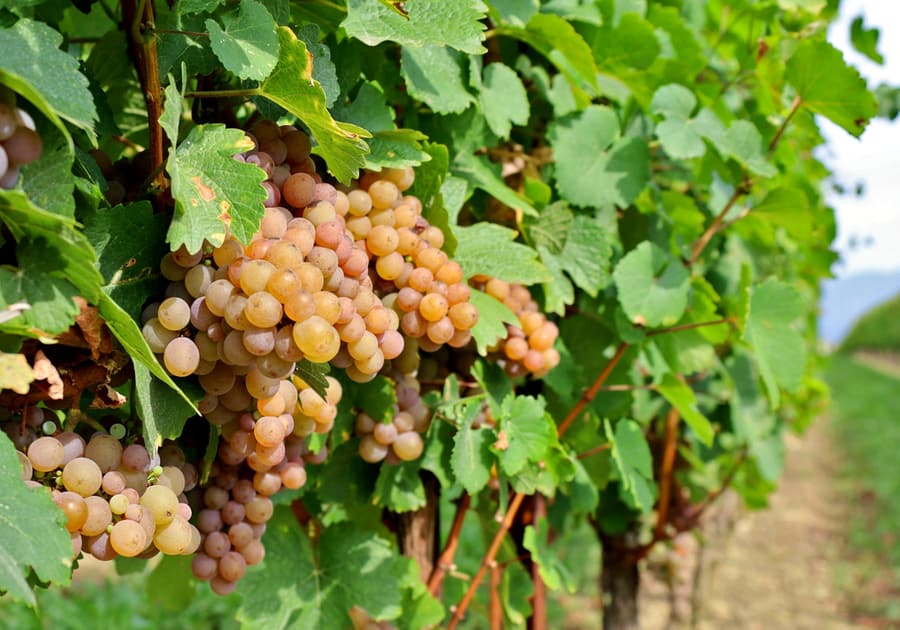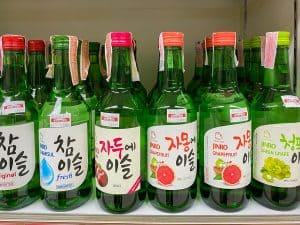
Someone once described Pinot Grigio to me as a white wine with almost no defining characteristics to set it apart from other white wines. While this may be true in some cases, it is the exception to the rule.
Pinot Grigio’s crisp and bright taste satisfies most wine drinkers’ tastes, but what does Pinot Grigio taste like?
Pinot Grigio tasting notes include lemon zest, raw almonds, minerality, salinity, cantaloupe, stone fruit, and honey. Pinot Gris from Alsace is sweeter and has hints of spices, flowers, and honeycomb due to oak barrel aging. The sweetest Pinot Gris is a dessert wine made with noble rot grapes. Fruit-forward dry Pinot Grigio from the New World has less acidity and more flavors of green apples, lemon, and peach.
We’ll go on a fact-finding mission to discover what Pinot Grigio tastes like in terms of flavor, aroma, and structure. Still, before that, we’ll look at the grape’s history and origin. We’ll also briefly investigate its French counterpart Pinot Gris and see how these two stack up to one another.
Pinot Grigio’s History

I firmly believe that understanding where something like a grape comes from will help you know the grape in a modern setting like ours. So, let’s dive in!
Pinot Grigio and Pinot Gris are interchangeable terms—Grigio refers to the variety’s Italian name. In contrast, Gris refers to the French title. Pinot Grigio’s history begins in the Middle Ages in Burgundy, where it was probably known as Fromenteau.
Then, as with all good (or bad) things in life, the grapes spread their vines along Pinot Noir and arrived in Switzerland around 1300.
King Charles IV reportedly enjoyed the grapes so much that he had vines imported into Hungary by Cistercian monks who planted the vines in 1375 on the slopes of Badacsony, which borders Lake Balaton. The vines became known as Szürkebarát, referring to the monks’ gray habits and meaning ‘gray monk.’
Not much is known about the intervening years. Still, a German merchant, Johann Seger Ruland, sort of rediscovered the grapes growing wild in the fields of the Palatinate (German wine-growing region).
Johann’s wine, produced from these ‘wild’ vines, became known as Ruländer. However, this was not a new grape, but Pinot Gris/Pinot Grigio (from Burgundy, France).
During the eighteenth and nineteenth centuries, Pinot Gris/Pinot Grigio grapes were popular options to plant in Champagne and Burgundy. But its popularity declined and fell out of favor because of unreliable crops and poor yields.
The same happened in Germany too. Luckily, during the twentieth century, innovative vine breeders developed cloned varieties with a more consistent and reliable crop that saved the grape from extinction or at least ignored and not planted often.
What Does Pinot Grigio Taste Like?

You’re spoiled for choice regarding Pinot Grigio (and its French counterpart, Pinot Gris). First, let’s quickly clear up the misconception that Pinot Grigio and Pinot Gris are the same wine. They are not. The style of wine makes them different wines, albeit produced from the same grape.
Pinot Gris is sweeter and typically hails from the Alsace region in France, and we’ll touch on this a bit later. Italian Pinot Grigio can come in one of three taste expressions: sweet and fruity, dry and fruity, and dry and mineral-like.
Overall Taste Profile
Usually, you can expect a light to medium-bodied white wine that’s slightly acidic with a silky-smooth texture that ranges from pale yellow to a deep, golden yellow. The tannins are low; you can expect an ABV between 11.5 and 13.5%.
Depending on which of the three varieties you choose, you can expect tastes such as citrus notes like lemon zest, raw almonds, cantaloupe, crushed gravel (who on earth puts gravel in their mouth?), and white peaches. We have covered how to drink Pinot Grigio in a previous post, and today our focus will solely be on the taste.
Remember, tasting notes are subjective and may vary from one bottle to the next. You might pick up consistent flavors and aromas from one bottle to the next, and at other times you may notice a new bouquet of flavors. Still, the familiar ones will always be present. So, let’s investigate!
Sweet and Fruity Pinot Grigio (a.k.a Pinot Gris)

French Alsatian Pinot Gris is the go-to wine to choose if you prefer sweet and fruity wines. Alsace borders Switzerland and Germany, so you might also find wines from these regions at the wine shop.
You can expect a multifaceted wine with bold, sweet flavors and medium acidity. In terms of taste, you can expect a wide variety of tastes.
To name a few: honey, exotic spices (like ginger, clove, and cinnamon), strong hints of crisp apples, candied lemon, sometimes even Meyer lemon, and mushrooms.
When the grapes are harvested late in the season, the acidity is lower and the sugar content even higher—especially if the grapes have been exposed to noble rot to maximize the flavor. Noble rot grapes lose much of their juice, increasing the sugar content in the remaining juice, hence the sweetness.
If this is your kind of wine, keep an eye out for the following descriptions on the Alsatian bottles:
- Sélection de Grains Nobles is exceptionally rare and basically translates to ‘selected from the noblest (best) grapes,’ i.e., the grapes have been exposed to noble rot.
- Vendange Tardives, or ‘Late Harvest,’ when the grapes are harvested late in the season to increase the sugar content and lessen the acidity.
- Grand Cru is the appellation used by the 51 Grand Cru climates in the Alsace region and can only be applied to the following grape varieties: Pinot Gris, Muscat, Riesling, and Gewurztraminer. The Grand Cru Pinot Gris wines are usually bolder in taste.
Dry and Fruity Pinot Grigio
We’re back in Pinot Grigio’s spiritual home, Italy. Sometimes winemakers may refer to their wine as a ‘Pinot Gris’ because of the fruit-driven tastes. Warmer climates such as those in the New World (USA (Washington, Oregon, and California), New Zealand, Australia, and sometimes more difficult, South Africa and Argentina).
Despite the dryness of the dry-and-fruity version of Pinot Grigio, you can expect ‘sweet’ tastes like yellow apple, lemon, and white peaches in each glass. Through malolactic fermentation, winemakers create a slightly less acidic wine with a richer, almost ‘oily’ or ‘buttery’ mouthfeel.
Particular bacteria convert the acids in the wine to smooth-tasting compounds after the initial alcohol fermentation.
Dry and Mineral Pinot Grigio
This is perhaps the most well-known version of Pinot Grigio. This style of Pinot Grigio is primarily produced in northern Italy, where the vines have ample space to grow in the steep alpine valleys.
The mountains and valleys help to protect the vines and grapes from harsh winter winds, and producers can produce wine throughout the year.
The trade-off is, of course, less sugar and more acidity. The grapes are grown across Alto Adige, Friuli, Lombardy, the Veneto, and Trentino and after Chardonnay, the second most popular wine in the USA.
This Italian wine is also the most acidic; sometimes, the taste can border on bitter almonds with citrus notes. The wine is aged in steel tanks to preserve acidity and flavors. Other flavors you can expect include mineral, salinity, green apple, lemon, and lime—you can almost compare it to lemonade without much of the sweetness.
Conclusion
Italian Pinot Grigio is the most acidic wine of the three styles, with hints of minerality, salinity, bitter almonds, green apple, and citrus fruits like lemon and lime. You could compare it to a lemonade with much less sugar than usual. It is a crisp, light wine that is a perfect refresher on warm sunny days.
You’ll find fruit-forward yet dry Pinot Grigio in the middle of the taste spectrum. The fruity and dry style of Pinot Grigio has notes of yellow apple, lemon, and white peaches with a ‘buttery’ or ‘oily’ mouthfeel thanks to the malolactic fermentation.
Last but not least, Pinot Gris from Alsace in France is the sweetest of the three styles. Expect hints of honey, exotic spices, crisp apples, Meyer lemons, and sometimes even mushrooms.









